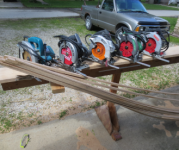I would say .045" is too far. I don't regularly check thickness any more ! As you stated routing the bead and cove brings the differences to light, and will tell you if your strips are off. Over the years, I remember scraping only a few strips, due to thickness.
To me,strip thickness is important. Uniformity saves a lot of sanding.
Routing strips is another topic for discussion, soon !
I remember before I wised up to Bead and Cove, how my strips would slip at the glue joints. I know the hull was only a 1/8" thick, in places, by the time I was finished sanding. Not good ! Especially when the strips were 1/4" thick to start !
Jim
To me,strip thickness is important. Uniformity saves a lot of sanding.
Routing strips is another topic for discussion, soon !
I remember before I wised up to Bead and Cove, how my strips would slip at the glue joints. I know the hull was only a 1/8" thick, in places, by the time I was finished sanding. Not good ! Especially when the strips were 1/4" thick to start !
Jim


